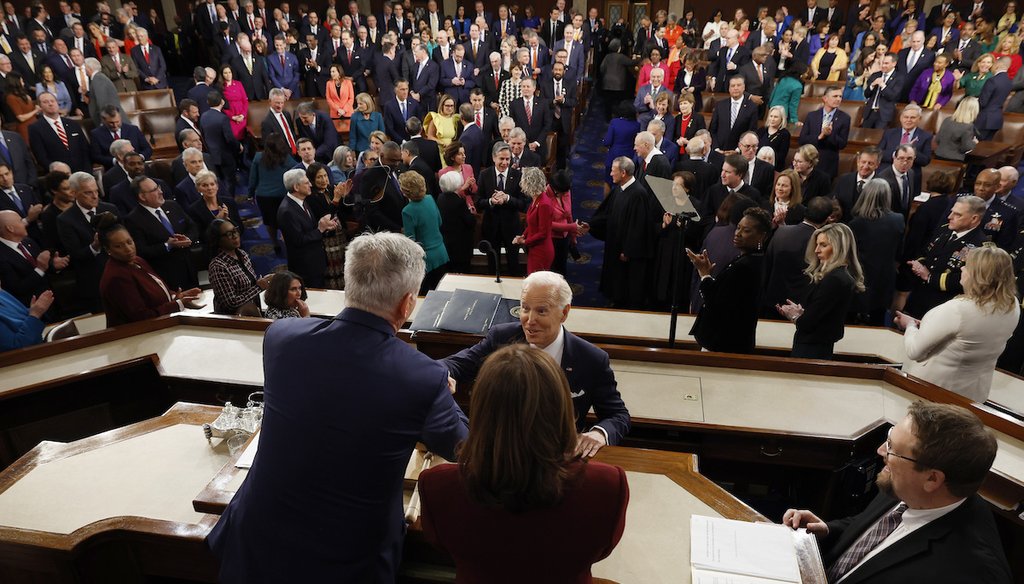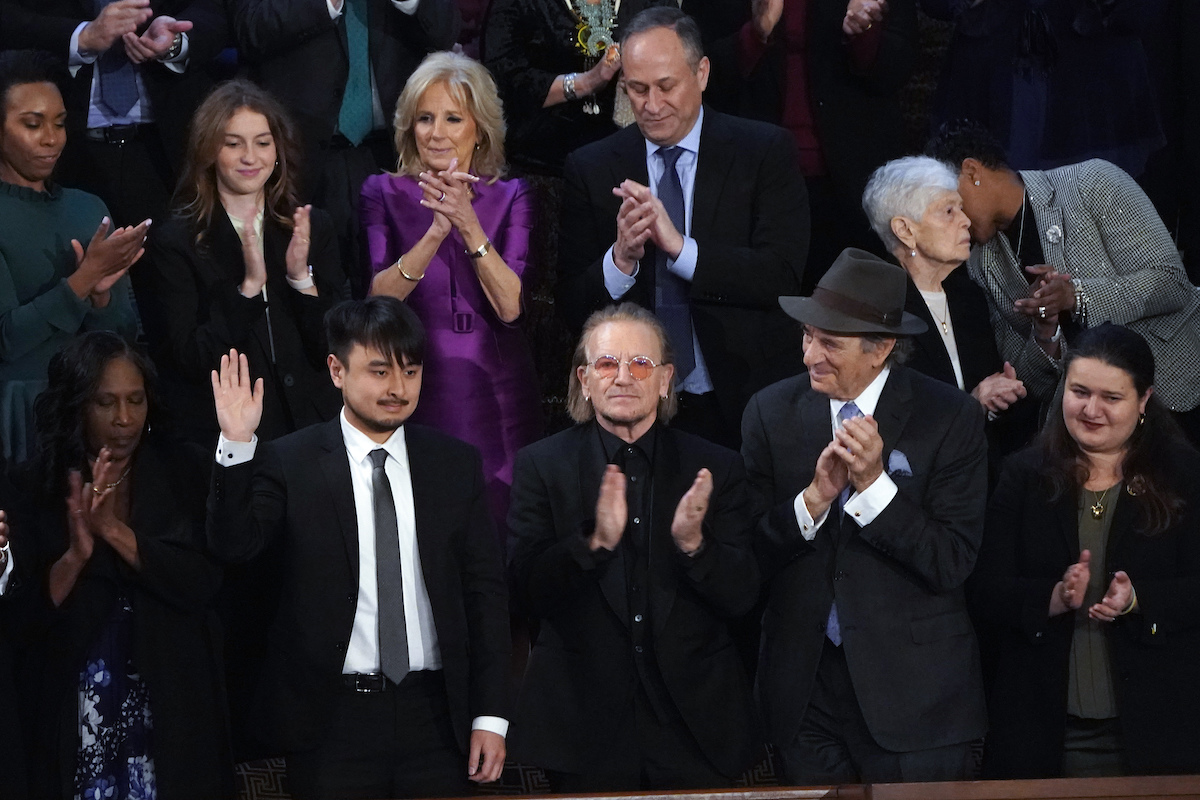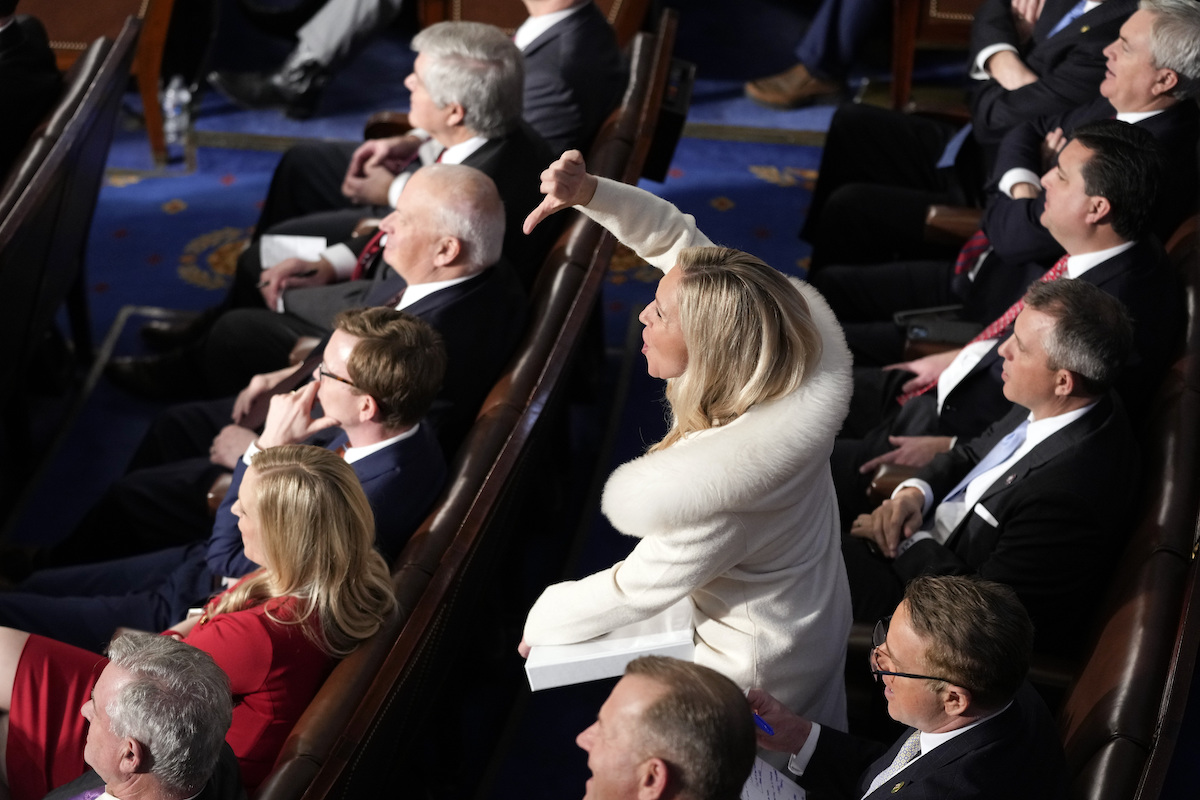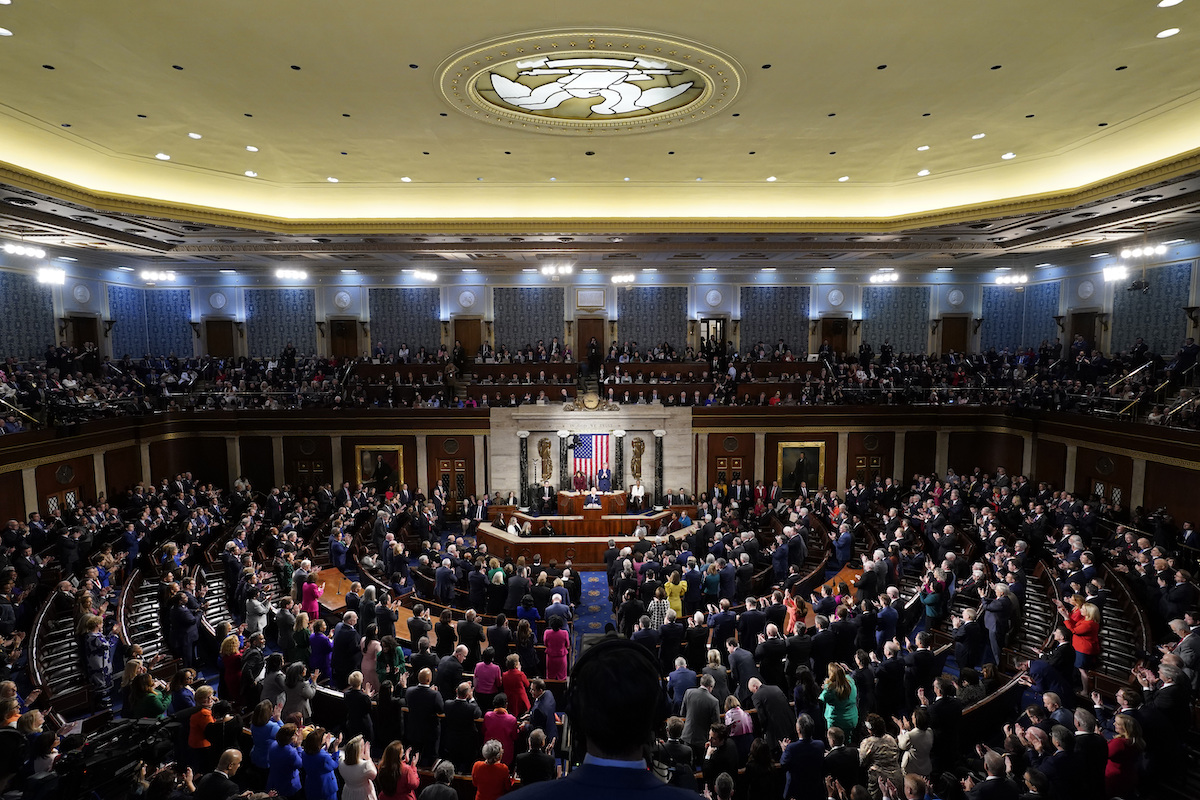Stand up for the facts!
Our only agenda is to publish the truth so you can be an informed participant in democracy.
We need your help.
I would like to contribute

President Joe Biden arrives and greets Speaker of the House Kevin McCarthy of Calif., as Vice President Kamala Harris looks on, before Biden delivers his State of the Union speech to a joint session of Congress, at the Capitol on Feb. 7, 2023. (AP)
If Your Time is short
- We also fact-checked the Republican response from Arkansas Gov. Sarah Huckabee Sanders.
- And we looked into the meaning of the “1870" pins some members of the Congressional Black Caucus and other Democrats wore to the speech.
UPDATED, Feb. 13, 2023: This article has been updated to include additional fact-checks.
Amid continued political polarization, and with opinion polls showing an uneasy public, President Joe Biden aimed to deliver a sense of fiscal and social relief during his State of the Union address. He used the speech, his first to a divided Congress, to call for improving police training and accountability and leveling the tax burden by raising levies on the wealthy.
By working together, Biden repeatedly said, Congress could "finish the job" his administration started when it pushed through major legislation to create jobs and infrastructure and bolster technology.
But Biden’s calls for bipartisan cooperation, including on raising the debt ceiling, seemed to rankle some Republicans. His warnings about what some congressional GOP members want to do with Medicare and Social Security led U.S. Rep. Marjorie Taylor Greene, R-Ga., to shout, "Liar!"
PolitiFact fact-checked Biden’s claim about desired GOP changes to the social programs and several others about the health of the economy, the infrastructure law and an assault weapons ban.
Sign up for PolitiFact texts
"Instead of making the wealthy pay their fair share, some Republicans want Medicare and Social Security to sunset. I’m not saying it’s the majority."
House and Senate Republican leaders say they don’t support this, but at least one senator has broadly floated the idea. Sen. Rick Scott, R-Fla., released a plan in 2022 that stated "all federal legislation sunsets in 5 years. If a law is worth keeping, Congress can pass it again." (Scott’s plan is a policy document that he is promoting again for his 2024 reelection.)
Scott’s proposal does not specifically call for a phase-out of Medicare and Social Security, which were created generations ago through federal legislation. And it doesn’t have widespread support among his party; Sen. Mitch McConnell of Kentucky, the Republican leader in the Senate, in 2022 said it would not be part of the party’s agenda.
Some House Republicans have left open the possibility of changing the programs, including raising the eligibility age. Sen. Ron Johnson, R-Wis., suggested in August that Congress approve Social Security and Medicare annually rather than as an automatic entitlement. But House Speaker Kevin McCarthy, R-Calif., said Jan. 29 during a CBS "Face the Nation" interview that cuts to Social Security or Medicare are "off the table."
"Thirty million workers had to sign noncompete agreements for the jobs they take. Thirty million. So a cashier at a burger place cannot walk across town and take the same job at another burger place and make a few bucks more. They just changed it, because we exposed it."
This has some significant errors.
The Federal Trade Commission estimates that up to 30 million workers have been required to sign non-compete agreements that bar them from working for a competing firm for a certain period after leaving their current job. But when Biden brought up fast-food workers, he confused noncompete clauses with a different legal restriction, no-poach clauses.
Until 2017, no-poach clauses were included in the agreements that local fast-food franchise owners signed with the parent company. The clauses barred them from luring workers away from fellow franchisees. The workers never saw those contracts, much less ever signed one.
The agreements did limit workers’ opportunities to receive higher wages. Still, nothing barred a McDonald’s worker, for example, from taking a better paying job with Burger King. Fast-food companies began phasing out the no-poach clauses after 2017. That isn’t something that "just" happened, and it had nothing to do with the Biden administration. It came after a McDonald’s worker took the company to court.
"I stand here tonight after we’ve created, with the help of many people in this room, 12 million new jobs — more jobs created in two years than any president’s created in four years."
Biden is correct about 12 million jobs created, but his comparison with previous presidents is Half True.
In raw numbers, Biden did oversee greater job growth than any post-World War II president’s first or second term in office. However, this achievement comes with asterisks.
Population growth skews the calculation, with Biden benefiting from a larger population. Measured by percentage increase from the time the president took office, which reduces the impact of population size, Biden rates in the middle of the pack.
And although Biden has outpaced every post-World War II president in job gains per year, he benefited by taking office on the upswing of a deep recession. He also has not faced a recession yet, something most of his predecessors experienced during their longer terms.
"Nearly 25% of the entire national debt that took over 200 years to accumulate was added by just one administration alone, the last one. Those are the facts, check it out."
This is Half True.
Biden’s number checks out, but the figure leaves out important details and context.
Assigning debt to a particular president can be misleading. Much of the debt traces back to decades-old, bipartisan legislation that set the parameters for Social Security and Medicare.
Also, the largest single spikes in the federal debt came in 2020 from the initial rounds of coronavirus pandemic relief legislation. Former President Donald Trump signed those laws, but they passed with broad bipartisan support.
Meanwhile, other ways of analyzing the data undermine his point.
If you look at the raw amount of debt added during a presidency, Barack Obama, who governed with Biden as vice president, ranks first and Trump ranks second.
Obama’s figure is so much larger than Trump’s partly because he served eight years, while Trump served only four. If you divide the debt accumulated during each president’s tenure by the number of years they served, Biden, with only two years in office, has seen the largest rise in debt, with Trump second and Obama third.
"In the last two years, my administration cut the deficit by more than $1.7 trillion."
This needs context.
Biden has a point that his administration has presided over smaller deficits than those under Trump’s administration, based on Congressional Budget Office estimates. But Biden’s remark leaves out important context.
The Congressional Budget Office’s most recent estimate projects a 2022 deficit of about $944 billion. That’s much less than the $2.7 trillion the previous year.
However, the debt had risen in 2021 because of a temporary phase of unusual federal spending because of the coronavirus pandemic. In absolute dollars, the current deficit is much more in line with what it was in pre-pandemic 2019.
"Inflation has fallen every month for the last six months while take home pay has gone up."
The first part is accurate: Year-over-year inflation peaked around 9% in June and has since fallen to a little higher than 6%.
Whether "take-home pay has gone up" is more complicated.
High inflation has hurt workers by cutting into their wages. For the first 18 months of Biden’s presidency, inflation-adjusted wages fell, from $373 a week to $359. Over the past two quarters, which equals six months, wage gains finally started to outpace inflation, rising to $364 per week.
Also, the numbers are averages. Many workers receive yearly salaries or wages that don’t adjust more than once a year, and they wouldn’t necessarily have received wage increases during the high-inflation period to which Biden was referring.
"In 2020, 55 of the largest corporations in America — the Fortune 500 — made $40 billion in profits and paid zero in federal taxes."
This is Mostly True.
A study by the Institute on Taxation and Economic Policy concluded that at least 55 large companies paid zero federal income taxes in 2020. Critics say that the financial disclosures used to compile the report are imperfect estimates of what the companies actually paid in taxes, since the accounting rules are different for the two types of filings.
Separate data from the Joint Committee on Taxation, which is based on actual tax returns, has supported the study’s general point that many big companies have small tax bills.
"In the 10 years the (assault weapons) ban was law, mass shootings went down. After we let it expire under a Republican administration, mass shootings tripled."
This is Mostly True. Studies that examined mass shooting deaths found that deaths fell during the 10 years the ban was in place, from 1994 to 2004, and rose dramatically when the ban expired.
Data in a key 2019 study showed that mass shooting deaths more than tripled in the decade after the ban ended.
Compared with the decade before the ban, there was a modest decline of 15 deaths during the ban. But the death toll from mass shootings went from an average of 4.8 per year during the ban years to an average of 23.8 per year in the decade afterward.
Some research suggests that limits on large-capacity magazines are the most important factor in reducing mass shooting deaths.
However, experts say it is difficult to determine whether the ban drove the decline in mass shooting deaths.
A joint session of Congress convenes to hear President Joe Biden's State of the Union address. (AP)
"We came together to pass the Bipartisan Infrastructure Law, the largest investment in infrastructure since President Eisenhower’s Interstate Highway System."
This is partially accurate, depending on how it’s counted.
The law includes $110 billion in funding to repair roads and bridges and support major projects, like a bridge connecting Kentucky and Ohio and a tunnel between New York and New Jersey. There are two ways to assess the impact: by the scale of individual projects, or the total spending on roads and bridges.
The infrastructure bill has allowed long-delayed projects to proceed, but comparing total spending over the years presents a challenge.
Biden is correct if you take the last big infrastructure push in the 2009 American Recovery and Reinvestment Act, which provided $27.5 billion for roads and bridges — a quarter of what’s in the 2021 infrastructure bill.
But the 2009 money came on top of funds that started flowing in 2005. When Adie Tomer, a researcher at the Brookings Institution think tank, ran the numbers, he found that as a percentage of GDP, total spending on roads and bridges reached 0.3% in 2010. The estimate for the Bipartisan Infrastructure Law as a percentage of GDP is projected to reach a high of 0.24% in 2027. Viewed that way, although the money in the bill is a relatively large amount, the actual spending from multiple bills was higher in 2010.
The Eisenhower Interstate Highway System was funded at $25 billion in 1956. That would equal about $275 billion today, but Biden didn’t say the 2021 bill surpassed the Eisenhower-era legislation. He said it was the most significant since then.
"We’ve launched a new border plan last month. Unlawful migration from Cuba, Haiti, Nicaragua and Venezuela has come down 97% as a consequence of that."
This is based on limited data. Preliminary numbers from the Department of Homeland Security show a 97% decline in encounters with migrants from these four countries from December 2022 to January. But there’s only about one month’s worth of data available so far, so it’s difficult to attribute declines exclusively to the new policy changes, experts say.
Biden said Jan. 5 that every month, 30,000 immigrants in total — from Venezuela, Haiti, Cuba and Nicaragua — will be allowed to enter the U.S. and work for two years under a parole program if they have a sponsor in the U.S. At the same time, Mexico also agreed to take 30,000 immigrants a month from these countries if they are expelled by U.S. authorities under the Title 42 public health order.
The announcement came in response to the high number of migrants from these countries reaching the southern U.S. border in fiscal year 2022.
"We’re finally giving Medicare the power to negotiate drug prices."
That's a touch too broad. Although the Inflation Reduction Act will allow Medicare for the first time to negotiate prescription drug prices with manufacturers, the provision will not take effect until 2026. The initial group of negotiable drugs will be limited to 10 that year. More drugs will be added to the negotiation list each year.
The U.S. Department of Health and Human Services is barred from negotiating on prescription drugs in the Medicare program until they've been on the market for several years.
"I’ve visited the devastating aftermath of record floods, droughts, storms and wildfires, from Arizona to New Mexico to all the way up to the Canadian border. More timber has been burned that I’ve observed from helicopters than the entire state of Missouri."
His claim about the fires isn’t supported by federal data and the White House provided PolitiFact with no data to back up the assertion.
In 2022, according to the National Interagency Fire Center, 7,577,183 acres burned across the country because of wildfires. That's equivalent to 11,839 square miles.
Missouri has a total land and water area of 69,707 square miles. To get a Missouri-sized collection of wildfire acreage, you would need to include most of the past six years worth of wildfires, from 2017 to 2022.
But Biden didn’t specify that he was referring to the past six years, which would have included four years in which he wasn’t in office and wouldn’t have been inspecting any wildfires by helicopter.
There have been about 22,973 square miles of wildfire damage during Biden’s presidency, a size still smaller than Missouri.
"Studies show that children who go to preschool are nearly 50% more likely to finish high school and go on to earn a two- or four-year degree, no matter their background they came from."
This is Mostly True.
There is one study that backs this up, and experts agreed that it’s credible.
Other studies of preschool programs have also shown gains in college attendance, but the rates have been lower, ranging from 12% to 18%.
As a general pattern, experts said, the more socioeconomically disadvantaged the group of students is, the bigger the boost preschool provides for future college attendance.
Louis Jacobson, Jon Greenberg, Amy Sherman, Maria Ramirez Uribe, Yacob Reyes and Madison Czopek contributed reporting.
Click here to read a Spanish version of this story.
Our Sources
See sources linked within fact-checks.
Politico, House GOP's 2023 forecast: Fiscal warfare, Oct. 24, 2022
Fox News, Republicans eye using debt limit hike to overhaul entitlement programs if entrusted with majority, Oct. 19, 2022
The Hill, GOP divisions over Social Security, Medicare cuts forecast tough fights ahead, Jan. 12, 2023
Bloomberg, Republicans Eye Debt Deal for Social Security, Medicare Panels, Feb. 6, 2023
Committee for a Responsible Federal Budget, White House Should Stop Demagoguing Social Security and Medicare, Feb. 6, 2023
Clip of Rep. Michael Waltz, R-Fla., on Fox Business, Jan. 9, 2023
Transcript: House Speaker Kevin McCarthy on "Face the Nation," Jan. 29, 2023
Office of Rep. Andy Ogles, Congressman Andy Ogles introduces first bill: The Inflation Reduction Act of 2023 to Repeal Democrats’ Record Spending, Feb. 2, 2023
The New York Times, Republicans, eyeing majority, float changes to Social Security and Medicare, Nov. 2, 2022
Joe Biden, transcript of remarks in the State of the Union address, Feb. 7, 2023
National Interagency Fire Center, "Wildfires and Acres," accessed Feb. 9, 2023
Census Bureau, "State Area Measurements and Internal Point Coordinates," accessed Feb. 9, 2023
The Federalist, "15 Whoppers Joe Biden Told During The State Of The Union Address," Feb. 8, 2023










































